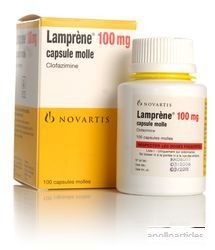Clofazimine (Lamprene) Canada
Description
Clofazimine is an antimicrobial medical product with expressed antileprotic action. It has a bactericidal action, and is also able to provide the anti-inflammatory effect.
Clofazimine inhibits the growth of the mycobacteria of leprosy (bacteria causing leprosy). Also, it may be used for the treatment of the leprous reactions observed during the treatment by other, less effective remedies. Often, this drug is prescribed in those cases when microorganisms (causative of the disease) produced the resistance to other antimicrobial remedies. Bacteria develop resistance to this drug with difficulty, and therefore the efficiency of the treatment by this remedy is 100%.
Directions for the use:
- leprosy (the prevention of the secondary resistance to the drugs of sulfonic layer)
- treatment of leprous, border-line, and border-leprous types of leprosy
- treatment of the leprous reactions
Recommendations
 The prescription of Clofazimine is made after the prior medical examination. It is necessary to have all analyses and find out the type of microbes. After the confirmation of the diagnosis leprosy the doctor has to indicate recommendations for the use, dosage and make sure of the absence of the contraindications.
The prescription of Clofazimine is made after the prior medical examination. It is necessary to have all analyses and find out the type of microbes. After the confirmation of the diagnosis leprosy the doctor has to indicate recommendations for the use, dosage and make sure of the absence of the contraindications.
Before prescribing the drug it is desirable to find out the sensitivity of microflora to it causing the disease in the patient.
- To treat lepra patients are prescribed 5-100 mg/day in combination with one or several antileprotic remedies
- For this diagnosis the prolonged use of the drug is needed. On the average a complete course of the treatment takes up to 2 years.
- Oftentimes, Clofazimine is used in combination with Diaphenylsulfonum and Rifampicinum
- To treat nodal fever the dose for adults is 100-200 mg/day within 2-3 months. Then, the dose is gradually reduced up to 100 mg per day.
- Children should be prescribed the lower dose in combination with the body weight. The optimal dose for children is 1 mg per 1 kg of the body weight once per day.
- Clofazimine tablets are taken during meals because the bioavailability of the drug is increased. It is better to take the tablet with milk to reduce the risk of the irritation of the mucous membrane of the gastrointestinal tract.
Patients with dysfunctions of liver and kidney do not require the adjustment of the dose. In these cases it is necessary to control general analyses of the blood and urine every 3 months.
Precautions and Contraindications
- Patients with exacerbation of the gastrointestinal tract should reduce the dose or increase the interval between drug uses
- If the patient has sensations of pain in the stomach or the upset of the gastrointestinal tract – diarrhea in the process of the treatment, it is necessary to refuse from the drug use for a while.
- An absolute contraindication for the drug use is an individual intolerance of Clofazimine or any other components of the drug.
- A qualified health care provider has to make a decision about the prescription of the drug during the pregnancy. If the benefit from the treatment increases the risk for the fetus, it is possible to take Clofazimine but a constant and complex supervision of the doctor is needed.
- It is not recommended to take the dose increasing 100 mg for a long period of time. This may cause an overdose and appearance of the side effects.
- In case of the fatigue, low appetite, rapid heartbeat, change of the color of the eyes, hair, lacrimal fluid, sweating, and urine the urgent termination of the drug is not needed.
- To prevent and reduce the side reactions it is recommended to take vitamins and drugs containing a lot of iron.

